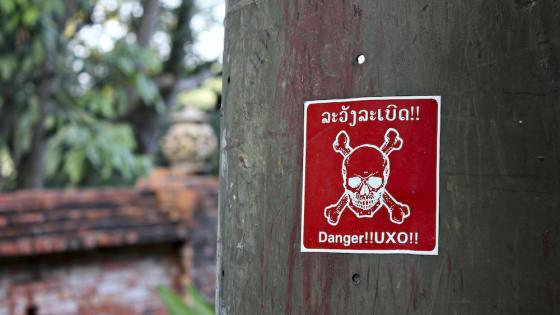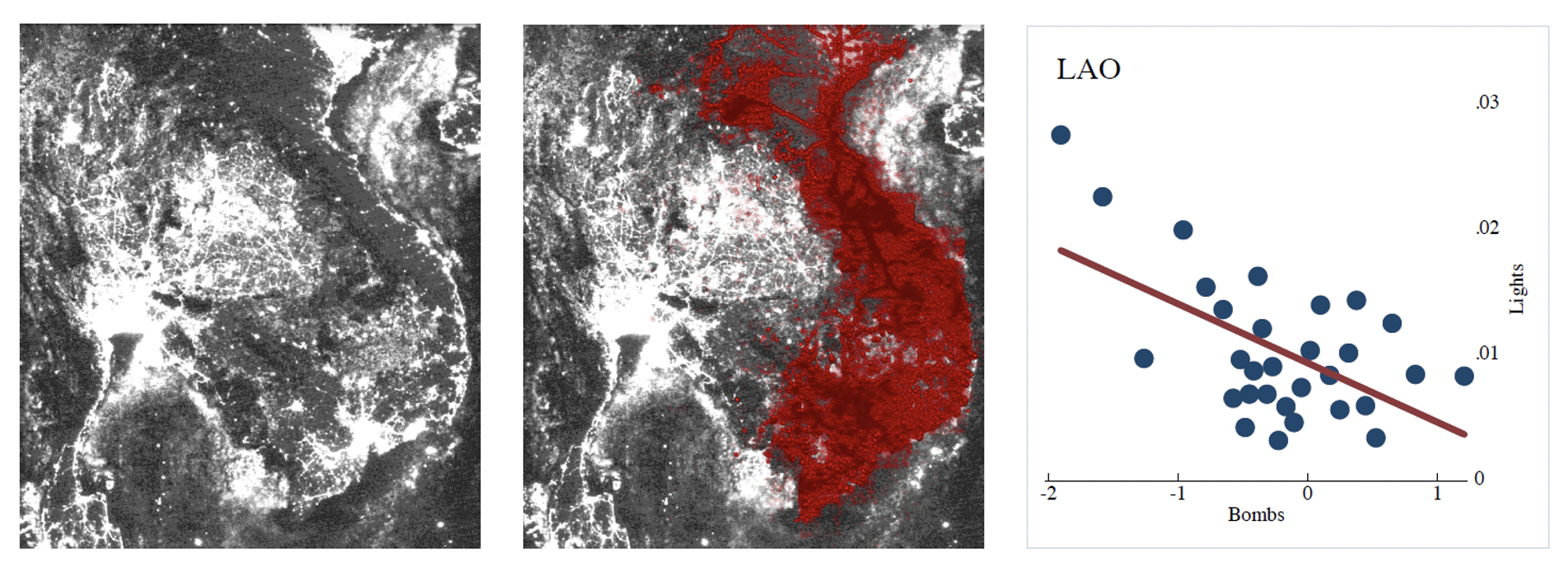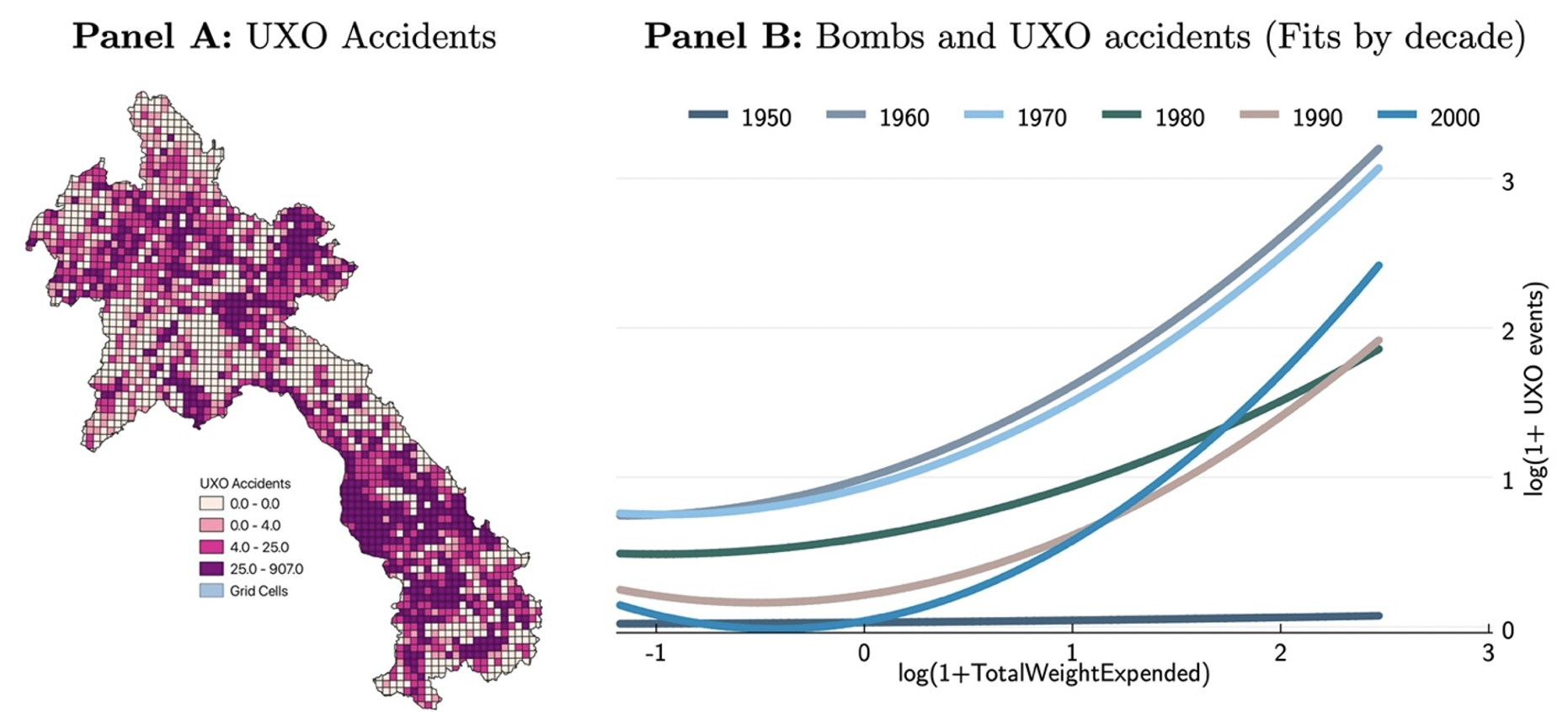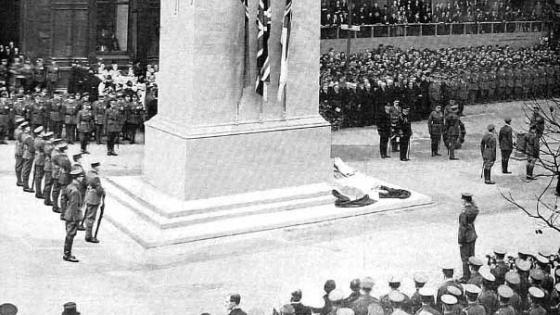The destructive nature of conflict is hard to overemphasise. Armed confrontations bring havoc not only to combatants, but also to local businesses and innocent bystanders. The World Bank estimates that immediately after a typical civil war, a country’s GDP is 15% lower and its citizens face increased poverty rates of up to 30% (Collier et al 2003, Collier 2007).
While the short-term effects of war are extensively documented in the literature (Blattman and Miguel 2010, Bauer et al. 2016), its long-term consequences have been more elusive. Several studies have found no long-lasting impact after bombings in Japan, Germany, and Vietnam (Davis and Weinstein 2002, Brakman et al. 2004, Miguel and Roland 2011, respectively). Others, echoing the quip by Charles Tilly, have even argued on behalf of the potential fiscal capacity gains emerging from war (Dincecco and Onorato 2018, Voigtländer and Voth 2012).
This emphasis on postwar recovery appears at odds with the ‘conflict trap’ hypothesis proposed by Collier (1999), according to which countries remain poor partly due to conflict. In a recent paper (Riaño and Valencia 2020), we test whether this is the case for Laos.1 From 1964 to 1975, Laos suffered one of the most intensive bombing campaigns in human history; as a result, the country is now severely contaminated with unexploded ordnance (UXO). Could this continued legacy of war be one of the key drivers of Laos’s underdevelopment?
Context and data
The Laotian Civil War (1953–1975) can be understood as a classic Cold War conflict. It pitted the Communist Pathet Lao against the Royal Lao Government. As part of its Cold War counterinsurgency operations in Southeast Asia, the US government conducted a series of military interventions in Laos from 1964 to 1975 (Congressional Research Service 2019). The country was of key geostrategic interest, given the neighbouring conflict in Cambodia and Vietnam (Dell and Querubin 2016). The US intervened in Laos, but the conflict remained secret at the time, as was eventually acknowledged.2 More than 270 million cluster bombs were dropped in the country during this ‘Secret War’, about a third of which did not explode. It is estimated that around 50,000 Laotians, most of them civilians, especially children, have been killed or injured by US bombs. However, less than 1% of these munitions have been cleared3 and at the current pace it could take more than a 100 years to clear the country (Congressional Research Service 2019), making this the number one development issue in Laos (Boddington and Chanthavongsa 2008).
To test our hypothesis, we combine data on the incidence of conflict with key economic indicators. Data on more than 1.6 million bombing missions conducted from 1965 to 1975 have been recently declassified and are available from the US Department of Defense. We link this geo-located information with data on nightlights from the US Air Force Defense Meteorological Satellite Program. We use the 1993, 2003, and 2013 missions to track the evolution of this variable over time. We complement this indicator using the Population and Agricultural Censuses of 2005 and 2011, at the village level. Additionally, through the Integrated Public Use Microdata Series (IPUMS) we have the 10% sample of the 2005 Census, which contains around 561,000 individual-level observations. Reports on UXO accidents come from the National Regulatory Authority (NRA) for Mine Action and is a daily panel, covering accidents from 1950 to 2011.
Empirical strategy
We proceed with our empirical analysis in the following way. First, we partition the country into small grid cells of 10 x10 kms. Working at this unit of observation allows us to control, via fixed effects, for time invariant characteristics at the province and even the district level (Laos has 18 provinces and 141 districts). Still, we take into account geographic and location characteristics such as: altitude, ruggedness, temperature, precipitation, latitude, and longitude. Additionally, we control for other characteristics relevant to this particular setting, such as distance to the 17th parallel, distance to the Vietnam border, and distance to the capital Vientiane. Still, estimating the regression using ordinary least squares (OLS) could have remaining problems, as bombing was probably not random.
To solve this potential endogeneity issue, we employ an instrumental variables (IV) identification strategy. As instruments we propose two variables. The first is the distance to the Ho Chi Minh Trail, in particular the part that was unknown to the US at the time, mostly constituted by underground tunnels. This instrument exploits the asymmetric information inherent in violent confrontations. Similarly, we use distance to the nearest US air base outside of Laos, established before the conflict started in the 1960s. This sensitive information comes from recently declassified CIA documents. We believe that the location of these bases – in South Vietnam, Thailand, and Japan – can be viewed as exogenous to the subsequent Laotian conflict.
Results
OLS results reveal a negative and significant relationship between conflict incidence (number of bombs dropped) and income (nightlights). A summary of this negative relationship can be seen in Figure 1. In terms of magnitude, we find that a one standard deviation increase in bombs leads to a 33% decrease in nightlights with respect to their mean, an effect that corresponds to a 9.3% fall in GDP per capita – a sizable decrease. Bombed regions are not only poorer today, but are also growing at slower rates than unbombed areas. The results are robust to using geographic and location controls, as well as netting out fixed effects.
Figure 1
Notes: The three panels of the figure depict a map of the Indochina peninsula with stable lights in 2013 (left), the same map overlaid with bombing events from 1965–1973 (centre), and a binned scatterplot of this relationship for Laos, net of geographic and location controls (right).
Our IV estimates confirm the baseline OLS and FEs findings. First, we find a negative and strong relationship between both distance to the Ho Chi Minh Trail and the nearest US air base and bombings. We also estimate a quadratic relationship in the first stage to allow for heterogeneous effects (Dieterle and Snell 2016). Using these instruments, we find again a negative and highly significant relationship between the number of bombs dropped and lights in 1993, 2003, and 2013, providing a more causal interpretation of our empirical estimates.
Mechanisms of transmission
To explore potential mechanisms of transmission, we divide the sample between villages that are above and below the median in terms of number of bombs received. We find that in the former, people have lower expenditures and higher poverty rates, so the nightlights results translate into concrete development outcomes. We also find that bombs are tightly related to UXO contamination of agricultural land, at the extensive and intensive margins. We confirm these findings using a high-frequency panel of UXO accidents starting in 1950, where we find more such accidents in heavily bombed areas from the 1960s to today (Figure 2).
Figure 2
Notes: Panel A of this figure depicts the spatial distribution of UXO accidents (events involving death, disability, or major injury) at the grid cell level in Laos. Panel B presents the relationship between intensity of the bombing campaigns in the country and the number of UXO accidents by decade.
Still, the negative effects of conflict appear to transcend the direct effects of UXO contamination, hampering other key economic investments as well. At a first pass, we observe that bombed areas are less dense today, and that they have lower levels of human capital in terms of literacy and health. Affected villages also appear to have worse public goods provision, in terms of electricity and water supplies. Expanding on these results at the individual level, using a difference-in-differences specification, we find that those who were still young in 1964, when the bombing campaigns started, received significantly fewer years of schooling. In modern times, now that these individuals have entered the labour market, they also have a lower probability of being employed as a whole. Moreover, even when employed, these individuals are more likely to be working in agriculture, and less likely in services, delaying the structural transformation of the economy (Figure 3).
Figure 3
Notes: This figure presents the event study analysis of the bombing campaigns from 1964 to1973 on long-term individual outcomes. It shows how difference-in-differences coefficients of cohort interacted with the intensity of bombing in the province of birth. Individual outcomes come from the census of population and housing of 2005. The name of each panel corresponds to the outcome of each model: Years of education, long-term migration, working in agriculture, and working in services.
Finally, we study the interaction with migration. We find that conflict decreased the rates of internal migration by around 10%. Using a triple difference specification, we are able to decompose the human capital and labour effects for migrants and non-migrants. We find that the negative education shock is concentrated among those who stayed (about 90% of the sample) rather than on those who moved. These results for human capital parallel those for sectoral employment, where again, non-migrants are more affected. Taken together, these rural-urban migration patterns help explain the negative long-run development consequences of the Laotian conflict, providing lessons for other countries still grappling with the multifaceted legacies of war.
Conclusion and policy
We contribute to the literature on conflict by showing the negative and sizable economic impact of a confrontation that formally ended decades ago. We also single out UXO contamination as a key element in the continued negative effect of war. Since the Laotian war officially ended, people have been affected directly through UXO accidents as well as indirectly through lower education and less labour mobility into modern sectors and urban centres. This pernicious combination of factors, among others, helps explain why Laos remains one of the poorest countries in the world today.
We believe that our findings could better inform policies for both affected and attacking countries. First, the demining agenda should take centre stage in conflict-stricken areas, as was the case in Mozambique (Chiovelli et al. 2018). Local leaders can also learn from the results presented with regard to the specific channels of transmission of the effects of UXOs. They can, for instance, improve the targeting of their existing policies accordingly, or implement new programs geared towards alleviating the lingering consequences of historical conflict. Policymakers in attacking countries might want to think twice about the long-term socioeconomic legacy of their military actions, weighing the large and permanent economic costs against their more immediate political and strategic objectives.
References
Bauer, M, C Blattman, J Chytilová, J Henrich, E Miguel, T and Mitts (2016), “Can War Foster Cooperation?”, Journal of Economic Perspectives 30(3): 249–74.
Blattman, C and Edward M (2010), “Civil War”, Journal of Economic Literature 48(1): 3–57.
Boddington, M and B Chanthavongsa (2008), “National Survey of UXO Victims and Accidents”, National Regulatory Authority for UXO/Mine Action Sector in Lao PDR (NRA).
Brakman, S, H Garretsen and M Schramm (2004), “The strategic bombing of German cities during World War II and its impact on city growth”, Journal of Economic Geography 4(2): 201–218.
Chiovelli, G, S Michalopoulos and E Papaioannou (2018), “Landmines and Spatial Development”, National Bureau of Economic Research Working Paper Series, No. 24758 (see also the VoxDev column here).
Collier, P (1999), “On the economic consequences of civil war”, Oxford Economic Papers 51(1): 168–183.
Collier, P, V L Elliott, H Hegre, A Hoeffler, M Reynal-Querol and N Sambanis (2003), “Breaking the Conflict Trap: Civil War and Development Policy”, World Bank policy research report. World Bank and Oxford University Press.
Collier, P (2007), The Bottom Billion: Why the Poorest Countries Are Failing and What Can Be Done About It, New York: Oxford University Press.
Congressional Research Service (2019), War Legacy Issues in Southeast Asia: Unexploded Ordnance (UXO), CRS Report.
Davis, D and W David (2002), “Bones, Bombs, and Break Points: The Geography of Economic Activity”, American Economic Review,92(5): 1269–1289.
Dell, M and P Querubin (2016), “More bombs, more shells, more napalm: Nation building through foreign intervention”, VoxEU.org, 16 August.
Dieterle, S G and A Snell (2016), “A simple diagnostic to investigate instrument validity and heterogeneous effects when using a single instrument”, Labour Economics 42, 76–86.
Dincecco, M and Onorato, M (2018), From warfare to wealth: the military origins of urban prosperity in Europe, Cambridge University Press.
Fergusson, L, A Ibáñez and J Riaño (2020), “Conflict, Educational Attainment, and Structural Transformation: La Violencia in Colombia”, Economic Development and Cultural Change 69(1): 335–371
Miguel, E and G Roland (2011), “The long-run impact of bombing Vietnam”, Journal of Development Economics 96(1): 1–15.
Voigtländer N and H Voth (2013), “The Three Horsemen of Riches: Plague, War, and Urbanization in Early Modern Europe”, The Review of Economic Studies 80(2): 774–811.
Riaño, J and F Valencia Caicedo (2020), “Collateral Damage: The Legacy of the Secret War in Laos”, CEPR Discussion Paper 15349.
Endnotes
1 Closely related papers have looked at the impact of demining campaigns in Mozambique (Chiovelli et al. 2018), the problem of UXOs for land use in Cambodia (Lin 2016) and how conflict has hampered structural transformation in Colombia (Fergusson et al. 2020).
2 https://obamawhitehouse.archives.gov/the-press-office/2016/09/06/remarks-president-obama-people-laos
3 https://www.thislittlelandofmines.com/






